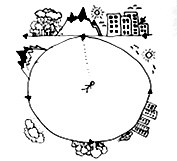REFIGURATIONS
Attention
In the next months I will pick up the threads that I first laid out when I set up Refigurations. In a series of short reflections I will begin to develop a vocabulary and framework for thinking about how to respond to the faltering of some of the stories and meanings that guide everyday life. As ever, these reflections will depart from the only reality I am an expert on: my own life. But where I can I will try to draw parallels to similar conversations I have followed or been part of elsewhere.
To begin with the beginning...
Understanding something, anything, depends on our ability to attend to it. Attending, stretching our mind toward something. In a very real way attention creates our sense of reality because what we attend to stands out – and what we don’t pay attention to fades away – against the background of our lives. Contemplative scholar Alan Wallace writes about this:
"Our very perception of reality is tied closely to where we focus our attention. Only what we pay attention to seems real to us, whereas whatever we ignore – no matter how important it may be – seems to fade into insignificance."
What doesn’t register with us and what we are unaware of doesn’t really exist for us within our personal reality. Sometimes we can muddle along a whole life without noticing this is going on. Other times the thing we are unaware of comes crashing into view when circumstances can no longer hold our ignorance. There are several things going on here (we can for example be wilfully ignorant or have an unacknowledged intuitive awareness of something) but for now I want to hold onto the insight that attention shapes our perception of reality.
If this is the case, there is a sense in which attention is all we have. It all comes down to your attention. Do I have it? Are you attending to these words, skimming them, looking for a point or a quote to extract? Are you willing to follow me down each sentence, to surrender to whatever path it is I’m treading? We can often find out about the quality of our attention from the feeling we get when we pause. Try it. Pause. Are you itching to get on, a little further through the text, onto the next article, link or page you just opened in your browser?
...
To really pay attention we have to be able to hold something in our mind without imposing ourselves on it. To be able to attend without creating an image in our mind through which we interpret what we experience, as Krishnamurti says. If we can do that we can move towards a deeper understanding of the things we attend to, a deeper quality in our perception of reality. The quality of attention seems directly related to the depth of our knowledge of something.
This is a basic but crucial point in a time where our attention is fraught by the density and speed of information around us. I know this too well from the times I’ve emerged from hours of internet browsing thinking “where the hell have I been?” barely remembering the stuff I’d read. The pull on our attention from news, ads, emails, tweets, likes and blogs(!) add up to electrifying waves of information that can drown out the silent or slow spaces we need to remain attentive. Perhaps we need something like Aldous Huxley’s mynah birds which, in his last novel Island, have been trained to cry out to the island’s inhabitants constantly calling “Attention!” to attention. If we find our own reminder birds we can begin to come back to the present more often. We can learn to suspend the compulsive creation of images through which we see reality. And once the habits that distract us cease their grip we can gradually begin to sharpen and refine our attention.
Attention is selective. It is a skill to be able to hold one’s attention. Attention needs exercise, discipline and patience. It needs practice. The best practice I know of is attending to the breath. It is simple – though not easy – and can be done anywhere at any time. The experience (and surprise!) of noticing the fullness of one’s own breath is a concrete example of what I mean by moving towards a deeper quality in our perception of reality. It leads into ever greater subtlety and ability to attend.
With careful attention to attention we can begin to notice how our awareness of something occurs in glimpses or moments of insight into previously ‘invisible’ aspects of our reality. And this points to the subject of the next post which is about what I call linear and non-linear modes of understanding and learning.
Thank you for your attention.
Tuesday, 17 February 2015

Refiguring on Tumblr




